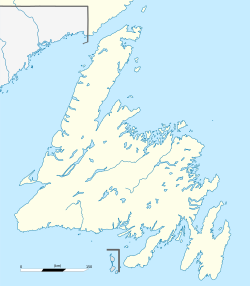Portugal Cove–St. Philip's
Portugal Cove–St. Philip's | |
|---|---|
Town | |
| Town of Portugal Cove–St. Philip's | |
 Portugal Cove, NL showing the two Bell Island ferries. Holy Rosary Church can be seen at the right of the picture. | |
| Motto(s): Where the Sun Meets the Sea | |
 Portugal Cove–St. Philip's Location of Portugal Cove – St. Philip's in Newfoundland | |
| Coordinates: 47°37′38″N 52°51′02″W / 47.62722°N 52.85056°WCoordinates: 47°37′38″N 52°51′02″W / 47.62722°N 52.85056°W | |
| Country | Canada |
| Province | Newfoundland and Labrador |
| Incorporated | 1992 |
| Government | |
| • Mayor | Carol McDonald[1] |
| • MP | Jack Harris (NDP) |
| • MHA | David Brazil (PC)[2] |
| Population | |
| • Total | 8,147 |
| • Density | 128.4/km2 (333/sq mi) |
| Time zone | UTC−03:30 (NST) |
| • Summer (DST) | UTC−02:30 (NDT) |
| Area code(s) | 709 |
| Highways | |
| Website | www |
Portugal Cove–St. Philip's is a rural seashore community located on the eastern Avalon Peninsula of Newfoundland in the province of Newfoundland and Labrador, Canada. The town is a bedroom community of the provincial capital of St. John's.
The provincial government operates a daily ferry service from Portugal Cove–St. Philip's to Bell Island.[3]
Geography[]
Located less than 15 minutes' drive from the provincial capital of St. John's, and covering 56.43 km2 (21.79 sq mi), it borders the City of St. John's to the east, and the Town of Paradise to the west. Located on Conception Bay, it is the site of a ferry terminal which provides daily access to and from Bell Island, and dozens of people commute from this tiny island to work in and around the capital city, daily.[citation needed] The town motto is Where the Sun Meets the Sea.
Demography and economy[]
Portugal Cove–St. Philips is a rapidly growing community. Amalgamated in 1992, and is home to approximately 7,366 people. The town’s population has a median age of 39.5 years, which is slightly lower than the provincial median of 40.6 years.[4] Most people work outside the community, commuting to St. John's or Mount Pearl, daily. Businesses within the community include farms, convenience stores, restaurants and cafes, construction, gardening centres, hair salons, garages and service stations, bed and breakfasts, and a taxi service. The inhabitants are predominantly English speaking.
History[]

The community is one of the oldest in Newfoundland and has a rich history. It was founded by the Portuguese and was one of the first villages established in the New World. The Portugal Cove area has historically been predominantly Roman Catholic, and is served by Holy Rosary Church.
It was attacked and burned by the French in 1696, was the site of the first road built outside the capital St. John's, it was also here that the giant squid or kraken of legend was discovered and documented. The community has a large body of folklore and oral traditions. Settled by fishermen from the west Country of England and Ireland it also has a small settler tradition from Jersey in the Channel Islands. It is named after Portugal. Fishing had been a mainstay since the 17th century and this has been on the downswing since the 1990s.
Notable people[]
- Marlene Creates (artist)
- Emma Churchill (Emma Dawson), founder of The Salvation Army in Newfoundland
- Craig Dobbin, chairman and chief executive officer of CHC Helicopter Corporation
- Andrew Furey, 14th Premier of Newfoundland and Labrador[5]
- Ed Picco, Nunavut MLA
References[]
External links[]
| Wikimedia Commons has media related to Portugal Cove – St. Philip's. |
- Populated coastal places in Canada
- Portuguese-Canadian culture
- Towns in Newfoundland and Labrador
- 1992 establishments in Canada

